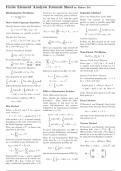Summary
Summary [MSc AP] Formula Sheet Finite Elements
- Course
- Institution
- Book
--- Satisfied? Please don't forget to leave a rating! --- This formula sheet covers the essentials of the 1st year's Applied Physics course "AP3001-FE - Finite Elements". This is kept to one page only, so it can be brought to the final exam (this is allowed at the time of writing this).
[Show more]




